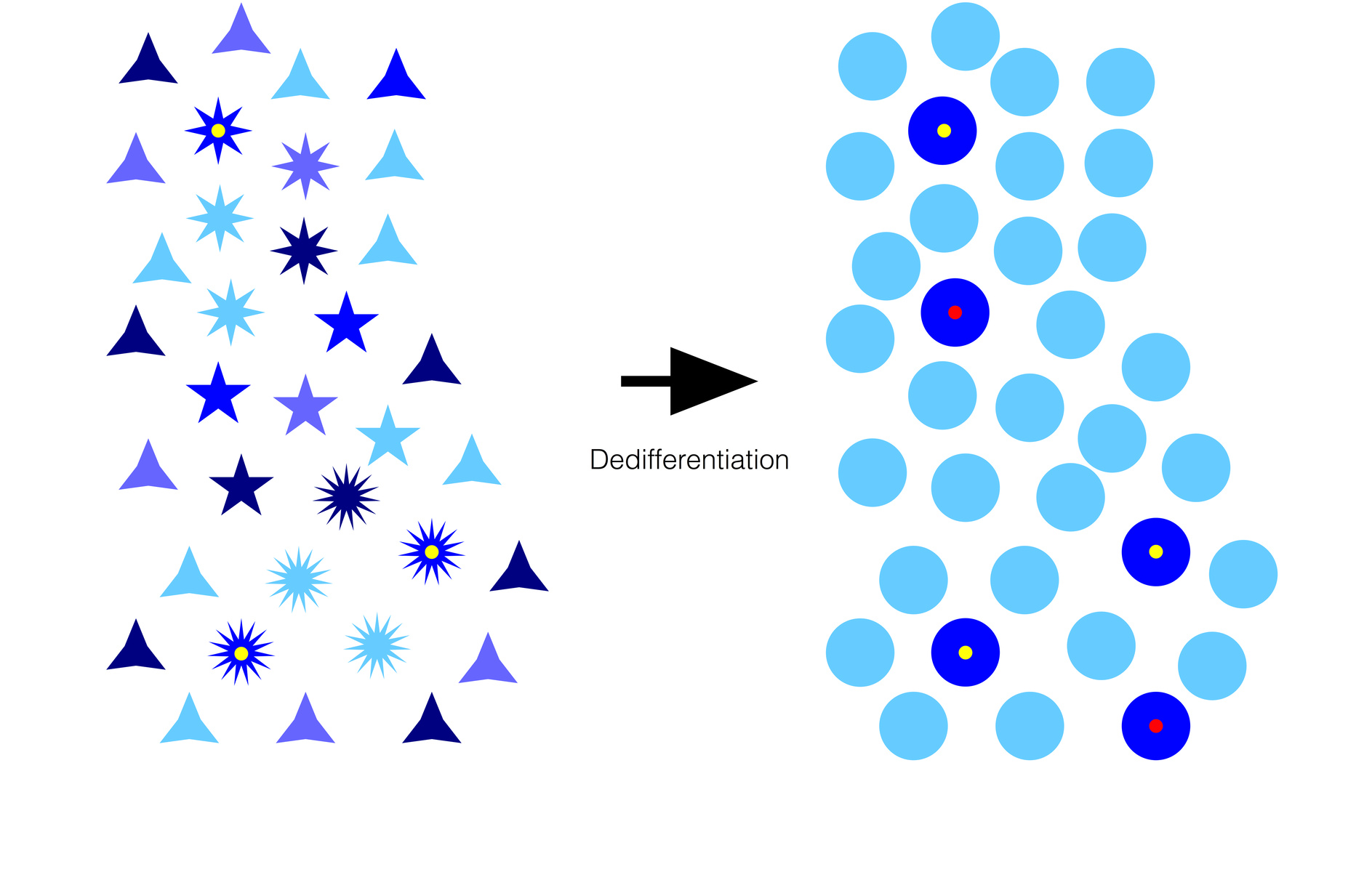
When it comes to understanding the intricacies of biology, there are always new discoveries and surprising revelations to be made. One such concept is dedifferentiation, a process that challenges the traditional notions of cell specialization. Dedifferentiation refers to the ability of mature, specialized cells to revert back to a more primitive, stem-like state. This phenomenon has captivated scientists and researchers worldwide, as it has the potential to revolutionize regenerative medicine and tissue engineering. In this article, we will explore 18 surprising facts about dedifferentiation, shedding light on its mechanisms, applications, and implications. Get ready to delve into the fascinating world of cellular plasticity and uncover the extraordinary abilities of our own cells!
Key Takeaways:
- Cells can transform like superheroes! Dedifferentiation allows cells to go back to a more basic form, opening doors for regenerative medicine and potential cures for diseases.
- Dedifferentiation is like a cellular time machine, reversing aging effects and offering hope for organ regeneration and personalized treatments. It’s a game-changer in the world of biology and medicine!
Dedifferentiation is a process where specialized cells revert back to a less specialized state.
Cells that have undergone differentiation, acquiring specific structures and functions, can be triggered to reverse this process and return to a more unspecialized state.
Dedifferentiation can occur naturally in certain organisms.
Some animals possess regenerative abilities that allow them to regrow lost body parts. Dedifferentiation plays a crucial role in this phenomenon, enabling cells to revert back to a pluripotent state and rebuild the lost tissue.
Dedifferentiation can be induced in the laboratory.
Scientists have developed various methods to induce dedifferentiation in cells for research purposes. This has opened up new avenues for studying cellular plasticity and exploring the potential for regenerative medicine.
Dedifferentiated cells can give rise to different cell types.
During dedifferentiation, cells regain the ability to differentiate into various cell types, similar to stem cells. This remarkable property holds great promise for regenerative therapies and tissue engineering.
Dedifferentiation is a key process in tissue regeneration.
When tissues are damaged or injured, dedifferentiation helps initiate the regeneration process by providing a pool of undifferentiated cells that can proliferate and differentiate into the required cell types.
Dedifferentiation plays a role in cancer progression.
In some cancer types, dedifferentiation allows cancer cells to acquire stem-like properties, facilitating their aggressive growth and resistance to therapies. Understanding this process could lead to new approaches for treating cancer.
Dedifferentiation is governed by specific genetic factors.
A network of genes and transcription factors regulates dedifferentiation. These factors rewire the genetic program of cells, allowing them to transition from a specialized state to a more undifferentiated one.
Dedifferentiation can be enhanced by certain environmental cues.
External factors such as injury, inflammation, or changes in the cellular microenvironment can influence the process of dedifferentiation and promote cellular reprogramming.
Dedifferentiation offers a potential solution for aging-associated degenerative diseases.
As we age, our cells and tissues lose their regenerative capacity. Harnessing the power of dedifferentiation could hold the key to reversing age-related degeneration and promoting tissue rejuvenation.
Dedifferentiation holds promise for organ regeneration.
By inducing dedifferentiation in specific cell populations, scientists aim to regenerate damaged or diseased organs, alleviating the need for transplantation and addressing the significant shortage of donor organs.
Dedifferentiation has the potential to revolutionize personalized medicine.
By dedifferentiating a patient’s own cells, it may be possible to generate customized therapeutic cells that can be used for cell-based therapies, minimizing the risk of rejection and maximizing treatment effectiveness.
Dedifferentiated cells can be reprogrammed to induced pluripotent stem cells (iPSCs).
Through a process called cellular reprogramming, dedifferentiated cells can be further manipulated to acquire the characteristics of pluripotent stem cells, offering a virtually limitless source of cells for various applications.
Dedifferentiation challenges the traditional concept of cell fate.
Traditionally, cell fate was considered irreversible. Dedifferentiation, however, demonstrates the remarkable plasticity of cells and challenges our conventional understanding of cellular identity.
Dedifferentiation research has implications for neurodegenerative diseases.
Understanding the mechanisms of dedifferentiation in neuronal cells could lead to new treatments for neurodegenerative conditions like Alzheimer’s and Parkinson’s disease, where loss of specialized neuronal cells is a characteristic feature.
Dedifferentiation can be harnessed for tissue engineering.
By inducing dedifferentiation in specialized cells, researchers can generate a population of cells that can be used to engineer complex tissues and organs in the lab, offering new possibilities for transplantation and regenerative medicine.
Dedifferentiation is a dynamic and complex process.
The process of dedifferentiation involves intricate molecular mechanisms and regulatory networks. Scientists are continually unraveling the underlying processes to gain a deeper understanding of this fascinating phenomenon.
Dedifferentiation can occur in both plants and animals.
While dedifferentiation is well-known in animal systems, it also plays a significant role in plant regeneration. Plants can dedifferentiate cells to initiate tissue repair and regrowth after injury or stress.
Dedifferentiation research is paving the way for novel therapies.
Understanding the complexities of dedifferentiation opens up remarkable possibilities for developing new therapies that harness the regenerative potential of cells, offering hope for conditions that were once deemed incurable.
As we delve deeper into the mysteries of dedifferentiation, we uncover the incredible plasticity and regenerative abilities of cells. These 18 surprising facts about dedifferentiation point us towards a future where cellular reprogramming holds the key to transformative medical advancements.
Conclusion
In conclusion, the process of dedifferentiation is truly remarkable and holds great potential in the field of biology. These 18 surprising facts about dedifferentiation have shed light on its importance and the various ways it can be leveraged for scientific advancements.
From the ability of cells to revert back to a pluripotent state, to the discovery of dedifferentiated cells in various organisms, to the potential for regenerative medicine, dedifferentiation has opened up new avenues of research and applications in biology.
By understanding the mechanisms of dedifferentiation and harnessing its power, scientists can further explore its potential in areas such as tissue regeneration, cancer research, and even aging-related studies. This field continues to evolve, and who knows what other surprises dedifferentiation may have in store for us in the future.
FAQs
Q: What is dedifferentiation?
A: Dedifferentiation is the process by which specialized cells revert back to a less specialized or stem cell-like state. It involves the loss of cellular specialization and a return to a more pluripotent state.
Q: Why is dedifferentiation important in biology?
A: Dedifferentiation is important in biology because it can unlock the potential for regeneration and the development of new tissues and organs. It also helps in the study of cellular reprogramming and the understanding of cancer cells.
Q: Can dedifferentiated cells be used in regenerative medicine?
A: Yes, dedifferentiated cells have the potential to be used in regenerative medicine. By reprogramming them to become pluripotent stem cells, scientists can generate specific cell types for transplantation and tissue repair.
Q: What organisms have been found to undergo dedifferentiation?
A: Dedifferentiation has been observed in various organisms, including plants, amphibians, and even mammals. It is a natural phenomenon that occurs in response to certain environmental or physiological cues.
Q: Are there any ethical concerns surrounding the use of dedifferentiated cells?
A: The use of dedifferentiated cells raises ethical concerns similar to those associated with stem cell research. However, with proper regulation and guidelines, dedifferentiation research can be conducted ethically and responsibly.
Dedifferentiation's potential to transform medicine is just the beginning. Dive deeper into cell biology with fascinating facts about embryonic stem cells, which possess unique properties and hold great promise. Regenerative medicine harnesses the power of dedifferentiation and other cutting-edge techniques to repair damaged tissues and organs. Uncover more about the incredible world of stem cells, from their role in development to their therapeutic applications.
Was this page helpful?
Our commitment to delivering trustworthy and engaging content is at the heart of what we do. Each fact on our site is contributed by real users like you, bringing a wealth of diverse insights and information. To ensure the highest standards of accuracy and reliability, our dedicated editors meticulously review each submission. This process guarantees that the facts we share are not only fascinating but also credible. Trust in our commitment to quality and authenticity as you explore and learn with us.


